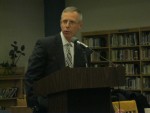Survey Outlines Mt. Pleasant Schools’ Infrastructure Needs

A study of Mount Pleasant School District facilities released last week highlighted a series of infrastructure projects that should be completed, but district officials must figure out how to pay for the improvements if work is pursued.
The Building Condition Survey, unveiled to the public at the Jan. 20 Board of Education meeting, is a visual inspection of all district buildings and their systems and must be done by a state-licensed architect or engineer.
The state mandated survey, which each district must complete every five years, was compiled by H2M Architects and Engineers. The results will be used by district officials to compile a five-year capital plan that will be submitted to the state Education Department (SED) by June, said Superintendent of Schools Dr. Susan Guiney.
Guy Page, vice president of H2M Architects and Engineers, said the survey will be reviewed with the director of facilities and the district’s Health and Safety Committee.
Some of its key points found that fresh air ventilation at Hawthorne and Columbus elementary schools does not meet state requirements, said Dana Hochberg, H2M’s senior architect. Parking and roadways have deteriorated at both elementary schools, the fields need renovations, masonry cracks must be repaired and lockers have exceeded their useful lives, Hochberg said.
At Hawthorne Elementary School, a new HVAC system is needed and the Columbus Elementary School ceilings should be replaced, Hochberg said.
At Westlake Middle School and Westlake High School, fresh air ventilation does not meet state standards; boilers, roofing and interior ceilings are substandard; parking and roadways have deteriorated; and vinyl asbestos tiles need to be removed, Hochberg said.
At the high school, exterior masonry and structural steel repairs are needed.
Trustee Thomas McCabe, concerned about air quality in the schools, asked H2M representatives whether it’s safe.
“It’s not unsafe,” responded Page, adding that new ventilation systems are needed as alternatives to having windows open.
Hochberg added that while the fresh air ventilation is failing to meet state standards, the district is not obligated by the state to take action because the schools were built decades ago, before the current regulations were in place.
Trustee John Piazza said if district officials decide extensive capital improvements are needed, the board should consider putting up a bond for residents’ approval.
He said paying for the work through the annual operating budget would cost more money.
In November 2014 and March 2015 voters resoundingly defeated expensive capital projects bonds that would have funded primarily infrastructure work at the district’s two secondary schools.
Guiney said it’s too early for her to make a recommendation about how to pay for any capital improvement projects. The options would be to pay for infrastructure work either through the budget or a bond.
Mount Pleasant is currently moving forward with a roof replacement and boiler project at Columbus Elementary School and masonry and related work at Hawthorne Elementary School. Both projects are funded through the 2015-16 operating budget approved by district residents last May.
